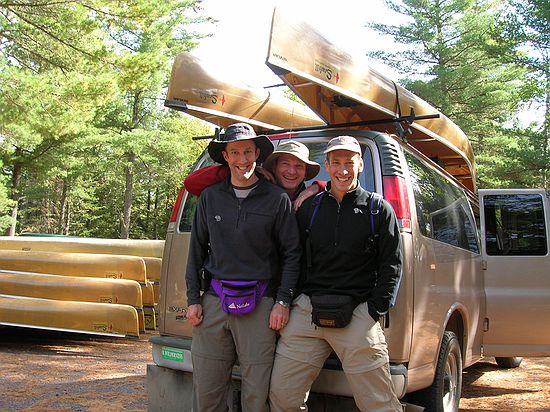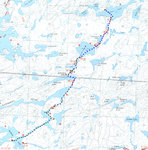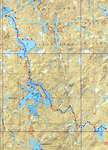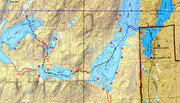| Boundary Waters Canoe Area Wilderness Adventure |
| September 2005 |

In April 2003 a group of us had been in Snowdonia attempting the 15 peaks challenge. There were 4 of us were travelling back together in the same car and we realised the 4 of us would be 40 years old within 4 months of each other at the end of 2005. We thought we should do something special to commemorate the event rather than one of our usual walking trips in the UK. The initial idea was to go trekking in the Himalayas. To cut a long story short, this did not work out and 3 of the 4 of us, John, Darrel and Pete, ended up deciding on a canoe trip in the Boundary Waters Canoe Area Wilderness which is in north Minnesota, USA. Pete had seen an article in a magazine covering the area and giving details of a canoe outfitters based at Sawbill Lake. On 18th September 2005 we set off from the UK for St Paul, Minnesota where we had arranged to stay with some friends for a couple of days before heading north to the Boundary Waters. After visiting various outdoor supply shops to pick up a few last minute pieces of clothing and equipment we headed up to the Boundary Waters on the 20th arriving late afternoon.
Day 1 - 11 miles
Due to the risk of Bears getting the food, our food pack had to be hauled up into the air every night. This involved slinging ropes between 2 trees and hauling the pack 10 feet up in the air and 6 feet away from any tree. When we were shown how to do this back at the Sawbill base they had 2 perfect trees just outside their cabin which were ideally sited with nice branches to catch the ropes over. However, the reality is that very few sites had trees like this. It took Pete over an hour before he had managed to get the ropes ready for the food pack. Even then I doubt that the pack the pack was quite as high or as far away from other trees as it should have been. We ended up cooking in the dark; what a first day! Day 2 - 10.7 miles
Day 3 - 16.4 miles
Since we had got a little behind on our planned route and since we really wanted to get back on track to stay at the best sites which had been recommended to us, we decided to push up the effort to catch up. We had always planned to have 2 rest days to enjoy the wilderness and spend some time in reflection and we did not want to sacrifice these in order to stay on schedule. During the first 2 days we had done all portages in 2 journeys and even though we would run back to pick up the second load this took quite a bit of time. Therefore we decided to double up and either carry a canoe and a large pack or 2 large packs along with the smaller packs, fishing rods etc in order to make only 1 journey. This proved exhausting although by the end of the 10 days we were doing this routinely without too much difficulty. Pete took the brunt of this effort this day carrying a large pack plus the larger 2 man canoe. We must have been carrying close to 100lbs each on each portage. Towards the end of the day there were 3 quite long portages in close succession to take us to our final destination on Tuscarora Lake. Due to the low water levels, the lowest in living memory, 1 of the lakes had almost totally dried up and the last 2 portages became a single much longer portage over 250 rods long! We were certainly glad when we got to camp on the island in the centre of the lake. This was our longest day travelling over 16 miles over 7 long hours barely stopping for lunch that we grabbed after 1 of the portages. We finally got to the island on Tuscarora Lake shortly before 6pm. Day 4 - rest dayUnfortunately the site on the island at Tuscarora Lake was a little spoilt. It had the potential to be a beautiful location and I think this was its downfall. There were very few fallen trees which could be used for firewood and some people had resorted to hacking off branches off live trees in order to avoid the work of finding dead wood. We were glad to have this day as a rest day as we were all exhausted after the previous long day. I took very few photographs this day since it poured with rain most of the day. Something I regret now since although the weather was poor it was still a day to remember. This was pretty much our only day where we had bad weather. Although we had a few cold and windy days later this was the only day we had any rain to speak of. After breakfast Pete packed a picnic and canoed off on to have some time to recuperate on his own. Darrel and I rigged up a shelter on the island and spent most of the day reading and chatting followed by some fishing when the rain eased off in the afternoon. Despite the weather I think we were all very glad to take this day as a rest day since after our epic journey the previous day we all needed a rest. Day 5 - 13.5 miles
In the wilderness area there is very little sign of human activity other than the paths left by the portages. There is a specific "Leave no trace" philosophy and you are instructed to take out everything you take in including all rubbish even if it's biodegradable. You are only allowed to chop fallen trees for firewood, you are only allowed to camp at designated locations and you are asked to take as much care as you can to leave the countryside undisturbed. However, set back from the edge of Little Saganaga Lake is an old Rangers cabin. You would never have known it was there unless you had been told about it and it is usually locked. We knew where the key was but when we got there we found it open. Inside was a log burning stove, 3 beds, food, an aluminium canoe and plenty of history. Just close by there is even a covered toilet. Luxury! We ended day 5 around 4:30pm at a beautiful site on Makwa Lake. Darrel and I had paddled ahead to find the camp only to hear that Pete who was a little way behind had been lucky enough to see a small moose family down by the water drinking. Despite having heard lots of moose at Davis Lake on day 3 this was our only sighting of moose the whole time. The site at Makwa Lake was one of the few sites which had 2 trees perfect trees ideally suited to suspend the food bag from. However, what I did not know until too late was that there was a wasps nest in the roots of one of the trees. I soon found out after I have walked over the nest as a large number of angry wasps soon came out and came after me. Despite moving swiftly away a couple of determined wasps followed and stung me! We took great care after this and they settled down after a short while. We had a great evening with another lovely evening at the site and quickly decided that this was our favourite site so far. Day 6 - rest dayOn the morning of day 6 we were rewarded with some incredible views of early morning mist rising and clearing over the lake. We had intended on moving on on day 6 down to Malberg Lake and having day 7 or 8 as a rest day but after packing up in the morning we had second thoughts. The day was such a lovely warm sunny day, and the site was such so beautiful set above the lake that we decided to bring forward our second rest day. Therefore we had to unpack and put up our tents again. We had taken down the ropes for suspending the food packs so these had to be put back up again! Since it was Pete who had suggested staying on he got the job of doing this and taking on the wasps! He kitted himself up with a mosquito net and gloves in case of trouble but in reality he was fine. He was careful not to trample over the nest so the wasps were not too bothered. Pete and Darrel headed off into the wilderness for some time alone and I stayed at the site in the sun relaxing and reading. Day 7 - 6.28 miles
Just by the shoreline of our camp someone had created some pools connected to the lake by piling up rocks at the edge to serve as keep pens for fish. Darrel discovered that in one of these pools were 4 or 5 small fish left by previous occupiers who had obviously caught them. We were tempted to eat these but they really were too small so we released them back into the water. In the evening whilst we were sitting by the camp fire we heard moose in the distance down at the waters edge. We put on our head torches and headed in their direction but unfortunately we were unable to spot them and by the time we had got to where we thought we should be able to see them they were gone. Day 8 - 10 miles
Despite the evening of day 7 being very warm, we had woken up to a change in the weather. Although we still had clear skies it had turned colder and was a little windy. We packed the fish to eat with dinner in the evening and headed off. We get to camp on Hazel Lake around 4:15pm which was early enough for Pete to head back up the lake to a portage to Knight lake to go for a run. We had expected to be able to do more walking or running in the wilderness in the afternoon and evenings but in reality the trees and undergrowth were too thick to allow this. Therefore the only place it was practical for anyone to run was on the portages. By the time Pete was back Darrel had cleaned and gutted the fish and we were getting ready for dinner. Darrel fried the fish in a little oil and it tasted wonderful, although by this stage there was precious little meat left! It made a lovely starter though. Day 9 - 6.5 miles
We got to Grace Lake with a strong wind from the south blowing direct down the lake. We had hoped to stay at the first site in the lee of the shore but once again we had been beaten there by another group. We therefore had to head off down the lake to find another site. The first site we stopped at was quite sheltered but is not very nice. There was little tent space and it was not particularly scenic so we decide to head further down the lake hoping not to have to canoe back against a strong head wind. We end up at a nice site at the end of the lake which unfortunately was in the full force of the wind offering little shelter. Pete managed to find an area of shelter for his tent but the tent Darrel and I shared was almost in the full force of the wind. We rig up the tarpaulin between some trees to give us some protection from the wind for the evening but it was too windy to risk leaving this up overnight though. Day 10 - 6.6 miles
Due to the colder weather we had briefly considered continuing back to Sawbill on day 9 as originally planned. We were really glad we had not done this though since day 10 had returned to the warmer weather with little wind. It was a perfect day to finish on. As we hit Alton Lake we started to see a few more people who were obviously out for a shorter trip over the weekend and we started to look forward to a nice hot sauna and shower that awaited us back at Sawbill. The last portage between Alton Lake and Sawbill Lake was a well worn path and from there it was a short paddle down the lake back to the Sawbill base. We arrived shortly after 1pm and after a few group photographs we eagerly headed for the showers. Darrel had arranged a day of climbing for the following day at Palisade Head which was about an hours drive back towards St Paul so we decided to camp for 1 final night at the Sawbill camp site before heading south. After thoughts...The whole trip was a wonderful experience I would recommend to anyone; I think we went out at a perfect time of year. We were probably lucky with the weather but it was warm enough for shorts and t-shirts most of the time and by the end of September all of the mosquitoes, no see um's and other insects had died off. The autumn colours had started to set in so the scenery was beautiful and it was late enough in the year so that there were few other people around. We only saw people at other sites a couple of times, at portages a couple of times and the occasional canoe in the distance. We really were able to enjoy the unspoilt wilderness in all its beauty. We saw and heard plenty of wildlife; we saw loon, the Minnesota State bird almost every day, we saw eagles soaring in the sky we heard moose and packs of wolves in the distance and regularly saw beavers and otters. Pete was even lucky enough to see moose drinking at the waters edge. I would also recommend Sawbill Canoe Outfitters. They provided everything we needed except clothes which we brought ourselves. The proprietor Bill Hansen has spent most of his life working at Sawbill and had plenty of advice which we were eager to accept. He did not make us feel at all foolish and went out of his way to help us and make sure we had an enjoyable time. He recounted many interesting tales as if he was telling them for the first time although I'm sure he had told many people over the years. He clearly loved the place and was keen for us to enjoy it as much as he did. The whole team at Sawbill were helpful and accommodating and we felt part of the family for the brief time we were with them. We are all now looking forwards to the next time we can get out there with our families. [1]
1 rod = 16.5 feet, 320 rods to a mile
|
| Copyright © 2005, John Bigg |









 BWCAW Pictures
BWCAW Pictures Short Videos
Short Videos GPS Tracks / Maps
GPS Tracks / Maps Home
Home